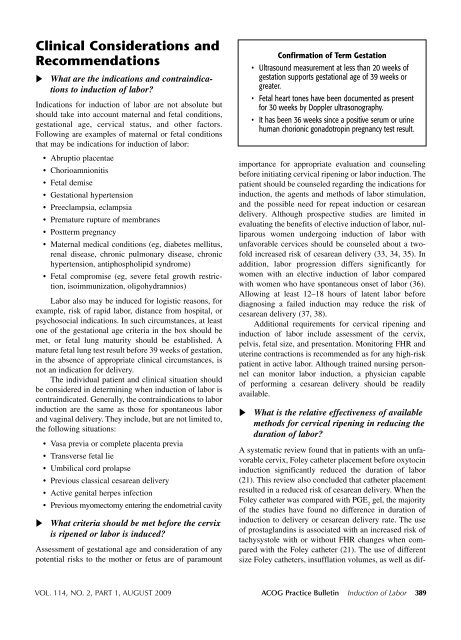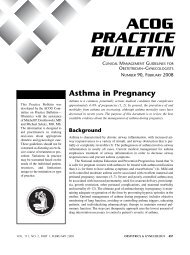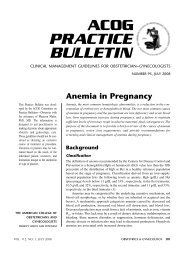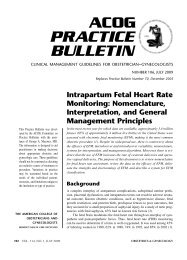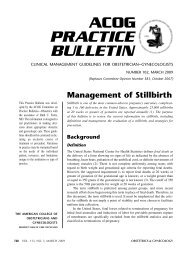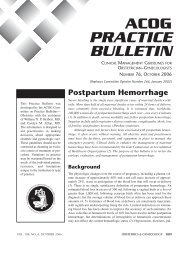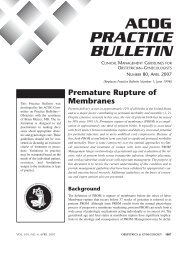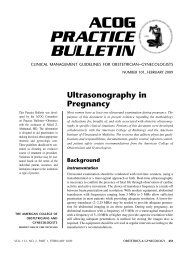ACOG Practice Bulletin
ACOG Practice Bulletin
ACOG Practice Bulletin
You also want an ePaper? Increase the reach of your titles
YUMPU automatically turns print PDFs into web optimized ePapers that Google loves.
Clinical Considerations and<br />
Recommendations<br />
What are the indications and contraindications<br />
to induction of labor?<br />
Indications for induction of labor are not absolute but<br />
should take into account maternal and fetal conditions,<br />
gestational age, cervical status, and other factors.<br />
Following are examples of maternal or fetal conditions<br />
that may be indications for induction of labor:<br />
• Abruptio placentae<br />
• Chorioamnionitis<br />
• Fetal demise<br />
• Gestational hypertension<br />
• Preeclampsia, eclampsia<br />
• Premature rupture of membranes<br />
• Postterm pregnancy<br />
• Maternal medical conditions (eg, diabetes mellitus,<br />
renal disease, chronic pulmonary disease, chronic<br />
hypertension, antiphospholipid syndrome)<br />
• Fetal compromise (eg, severe fetal growth restriction,<br />
isoimmunization, oligohydramnios)<br />
Labor also may be induced for logistic reasons, for<br />
example, risk of rapid labor, distance from hospital, or<br />
psychosocial indications. In such circumstances, at least<br />
one of the gestational age criteria in the box should be<br />
met, or fetal lung maturity should be established. A<br />
mature fetal lung test result before 39 weeks of gestation,<br />
in the absence of appropriate clinical circumstances, is<br />
not an indication for delivery.<br />
The individual patient and clinical situation should<br />
be considered in determining when induction of labor is<br />
contraindicated. Generally, the contraindications to labor<br />
induction are the same as those for spontaneous labor<br />
and vaginal delivery. They include, but are not limited to,<br />
the following situations:<br />
• Vasa previa or complete placenta previa<br />
• Transverse fetal lie<br />
• Umbilical cord prolapse<br />
• Previous classical cesarean delivery<br />
• Active genital herpes infection<br />
• Previous myomectomy entering the endometrial cavity<br />
What criteria should be met before the cervix<br />
is ripened or labor is induced?<br />
Assessment of gestational age and consideration of any<br />
potential risks to the mother or fetus are of paramount<br />
Confirmation of Term Gestation<br />
• Ultrasound measurement at less than 20 weeks of<br />
gestation supports gestational age of 39 weeks or<br />
greater.<br />
• Fetal heart tones have been documented as present<br />
for 30 weeks by Doppler ultrasonography.<br />
• It has been 36 weeks since a positive serum or urine<br />
human chorionic gonadotropin pregnancy test result.<br />
importance for appropriate evaluation and counseling<br />
before initiating cervical ripening or labor induction. The<br />
patient should be counseled regarding the indications for<br />
induction, the agents and methods of labor stimulation,<br />
and the possible need for repeat induction or cesarean<br />
delivery. Although prospective studies are limited in<br />
evaluating the benefits of elective induction of labor, nulliparous<br />
women undergoing induction of labor with<br />
unfavorable cervices should be counseled about a twofold<br />
increased risk of cesarean delivery (33, 34, 35). In<br />
addition, labor progression differs significantly for<br />
women with an elective induction of labor compared<br />
with women who have spontaneous onset of labor (36).<br />
Allowing at least 12–18 hours of latent labor before<br />
diagnosing a failed induction may reduce the risk of<br />
cesarean delivery (37, 38).<br />
Additional requirements for cervical ripening and<br />
induction of labor include assessment of the cervix,<br />
pelvis, fetal size, and presentation. Monitoring FHR and<br />
uterine contractions is recommended as for any high-risk<br />
patient in active labor. Although trained nursing personnel<br />
can monitor labor induction, a physician capable<br />
of performing a cesarean delivery should be readily<br />
available.<br />
What is the relative effectiveness of available<br />
methods for cervical ripening in reducing the<br />
duration of labor?<br />
A systematic review found that in patients with an unfavorable<br />
cervix, Foley catheter placement before oxytocin<br />
induction significantly reduced the duration of labor<br />
(21). This review also concluded that catheter placement<br />
resulted in a reduced risk of cesarean delivery. When the<br />
Foley catheter was compared with PGE 2<br />
gel, the majority<br />
of the studies have found no difference in duration of<br />
induction to delivery or cesarean delivery rate. The use<br />
of prostaglandins is associated with an increased risk of<br />
tachysystole with or without FHR changes when compared<br />
with the Foley catheter (21). The use of different<br />
size Foley catheters, insufflation volumes, as well as dif-<br />
VOL. 114, NO. 2, PART 1, AUGUST 2009 <strong>ACOG</strong> <strong>Practice</strong> <strong>Bulletin</strong> Induction of Labor 389


